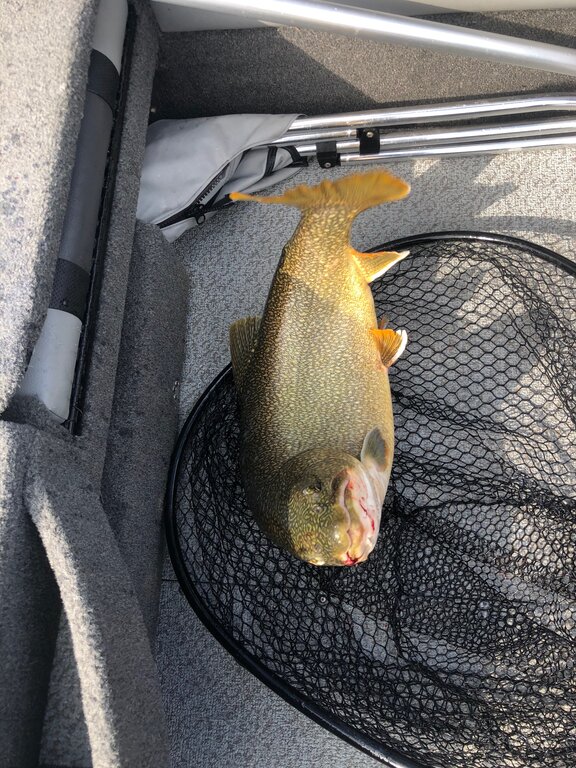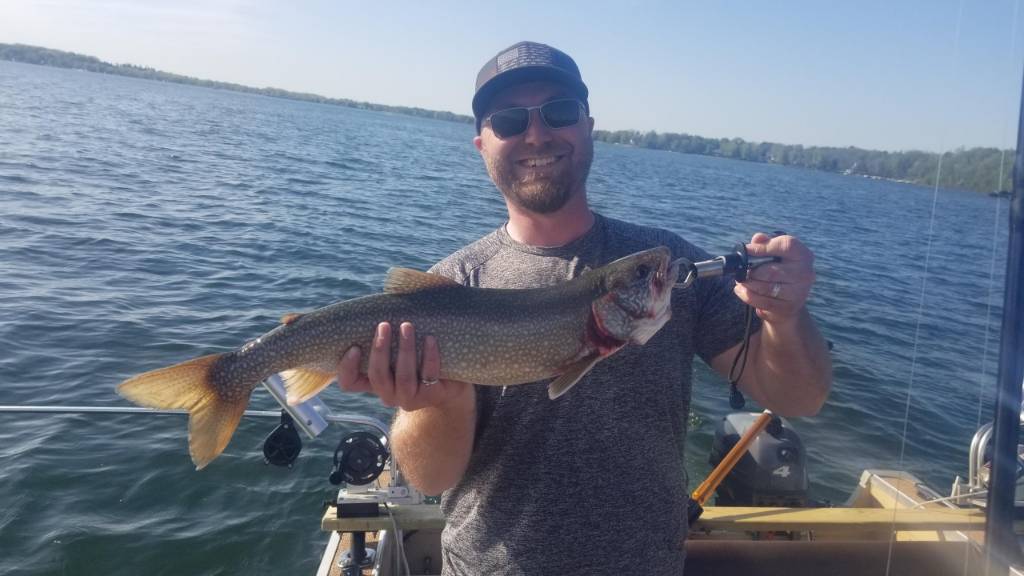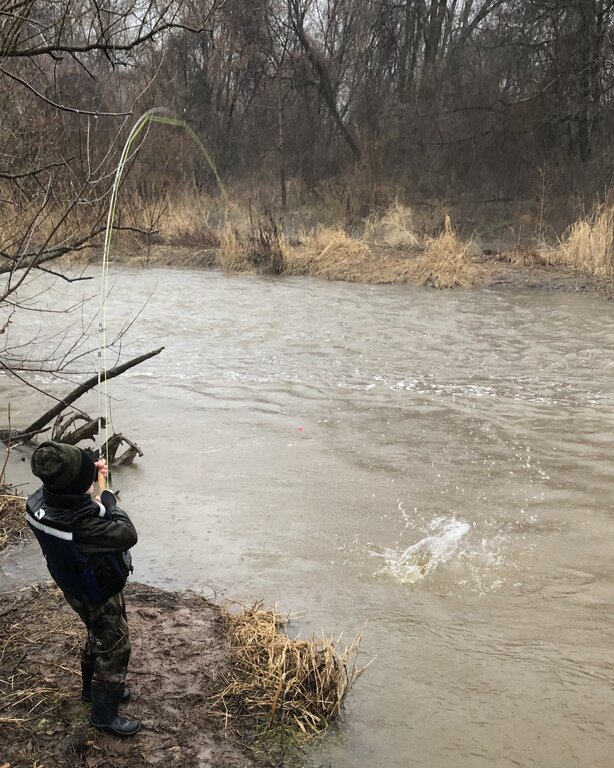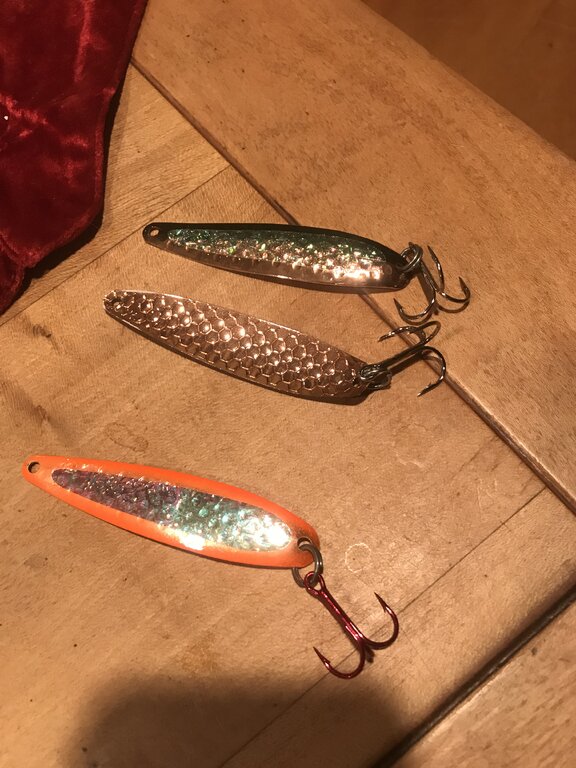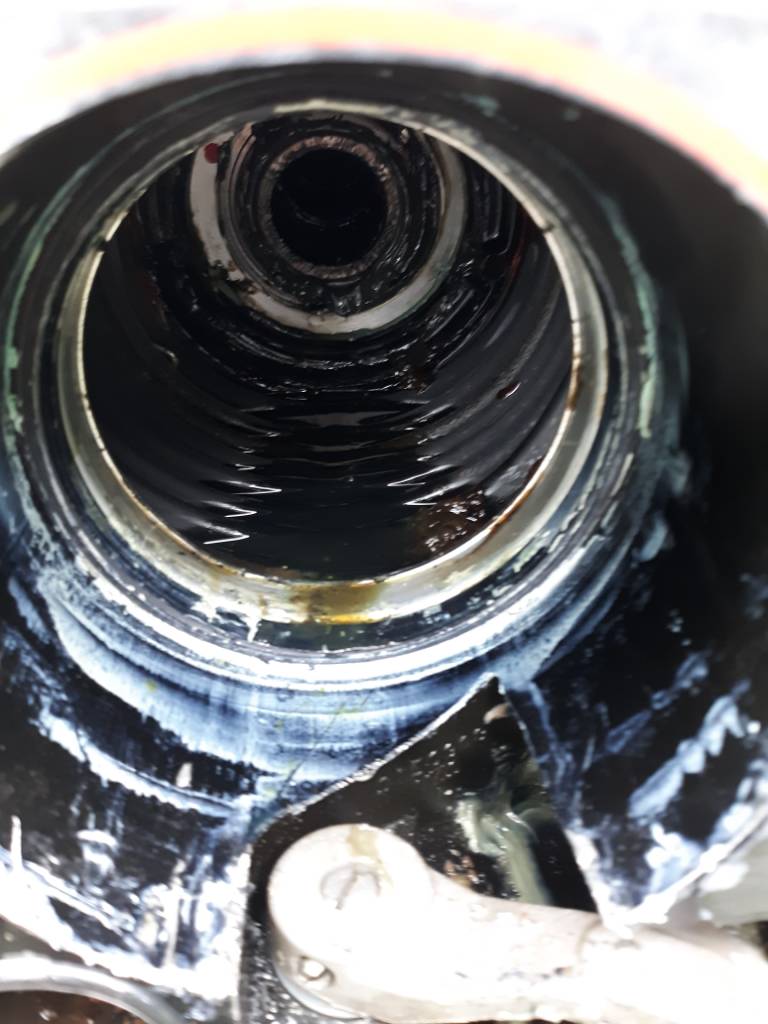-
Posts
508 -
Joined
-
Last visited
Content Type
Profiles
Forums
Events
Gallery
Store
Everything posted by mudflat
-
1st make sure your kicker motor is trimmed out a little so that the prop is pushing straight back. If the motor is trimmed all the way in your thrust will be slightly downward and the motor will have less control. Then adjust your sea state filter downward, I usually have mine set at 1 or 2 because I think it actually helps to let the boat wander around a little when trolling Code 1 Sea State Filter. If the Autopilot seems to be too active in rough water (the kicker motor is overactive) but works perfect in calm water, adjusting the Sea State Filter may help. Factory default sets this code at the top of its range (4) which is most active (least active is 1) . Most of the time you will want to run with this parameter at the the top of its range. To decrease the autopilots sensitivity in rough water 1) Press and release [SETUP}on the handheld, the setup LED will be lit. 2) Press the [IDLE/RES] button and light up the number 1 LED . 3) Press the down arrow button to decrease the autopilots sensitivity. Note: When the autopilot is shut off, the autopilot will return to its factory default setting unless the setting is saved See page 28, Step 5.
-
Sodus's public launch on Rte 14 is open and free You can also launch at Arney's and Sodus Bay Marina for a charge The Coast Guard launch is closed for the rest of the summer
-
I would get a 2 cylinder 4 stroke, not much performance difference between 6 and 8 hp Any 2 cylinder motor will run much smoother than a single cylinder.
-
https://www.hodgesmarine.com/stagx1400gw-standard-horizon-gx1400g-fixed-mount-vhf-wgps.html Standard Horizon has a $50 rebate going on now till 6/30 on their GX1400g model
-
-
The breaker on the rigger will protect the motor from overload but it doesn't protect the supply wire or your boat. A GFCI receptacle works on an AC circuit to protect you from any current leakage to ground. You should still have a fuse near the battery on the supply wire, probably 15 to 20A depending on what gauge wire you are using.
-
I don't believe a TR-1 can handle a kicker and an I/O together. The pump and hydraulic cylinder are both sized for just a kicker and I don't think they will have enough power to move both the kicker and an I/O . Even if the I/O moved very easily, which mine doesn't, at times the TR-1 is very active and I'm sure you would burn out the pump in a short time trying to steer both motors. To use an EZ steer I think you would need to have hydraulic steering on your I/O and install a full size hydraulic AP.
-
Dropping two bags will definitely help settle the bow down and hold a straight course when it gets rough. You will also increase the rpm's and prop thrust which also improves your steering. I have an extra set of 24" bags you can borrow to try out on your boat. Stop by sometime when you see the cover come off my boat on Stock Farm Rd.
-
I agree with Rick I have both a B60 and a TM150 with Lowrance HDS 9's installed on my PennYan and I use the B60 98% of the time when trolling. On my small boat I'm using the Lowrance OEM 50/200 transom mount transducer and get a picture just as good as the B60.
-
DEC Delivers Press Release - Information to keep you connected and informed from the NYS Department of Environmental Conservation Share or view as a web page || Update preferences or unsubscribe DEC and State Parks Announce Boat Launch Dock Installations Underway Boat Launches Are Becoming Available Across the State to Access Great Fishing or Enjoying a Day on the Water Boaters and Anglers Encouraged to Use Boat Launches Safely and Responsibly, Recreate Locally, and Practice Social Distancing to Prevent Community Spread of COVID-19 The New York State Department of Environmental Conservation (DEC) and the Office of Parks, Recreation and Historic Preservation (State Parks) today announced that boat launch installations are ongoing across the state to ensure boaters have access to New York State's abundant recreational opportunities. Each spring, DEC and State Parks regional staff work to install docks at all sites, often before the opening day for various sportfish species. During the COVID -19 public health crisis, when boating and fishing DEC and State Parks encourage New Yorkers to recreate locally and use the hashtag #RecreateLocal, avoid busy waters, and follow the guidelines on DEC's website about fishing responsibly in New York State. Docks are being installed at boat launches across the state. Schedules for boat launch installations can change based on water levels, weather, and ice conditions. Most sites are open for public use even if the boarding dock is not installed. Boaters are encouraged to call their regional fisheries office or State Park to check the boat launch status. Restrooms at these facilities will remain closed out of an abundance of caution to prevent the community spread of COVID-19. Boat launches at DEC campgrounds remain closed at this time. Please note that the boat launch at Lake Flower in Saranac Lake is restricted due to an adjacent construction project. For more details, go to DEC Lake Flower Boat Launch announcement. A list of New York State Boat Launching Sites (PDF, 7.7 MB) contains boating access and launching areas available to the public, as well as helpful information on launching and retrieving boats and aquatic invasive species. For people with mobility issues, DEC also maintains a photo album of accessible launch and fishing sites. For information about non-DEC boat launch site operations, please contact the specific municipality or agency. Please continue to follow the CDC/New York State Department of Health guidelines for preventing the spread of colds, flu, and COVID-19: Try to keep at least six feet of distance between you and others. Avoid close contact, such as shaking hands. Wash hands often or use a hand sanitizer when soap and water are not available. Avoid surfaces that are touched often, such as rails, posts, and tie off cleats. When boating and fishing, DEC and State Parks recommend New Yorkers to recreate locally, avoid busy waters, and follow the guidelines on DEC's website about fishing responsibly in New York State. If an angler arrives at a parking lot and there are several cars, consider going to another parking lot. If an angler is fishing upstream, they should fish downstream of the other angler or consider fishing another day. Do not share a car with people not in your household while traveling to fishing or boating sites. Anglers fishing from boats should always be able to maintain at least six feet of distance between one another. For more information about the benefits of being outdoors safely and responsibly, go to DEC's website. New York's waters remain cold throughout the spring. Life jacket wear is required through May 1 on pleasure boats less than 21 feet long and dressing in layers is recommended to avoid hypothermia. Boaters should be alert at all times and follow the rules of the nautical road. Under Brianna's law, all operators of motorized vessels must take a safe boating course and earn a safe boating certificate by 2025. For information on recreational boating in New York, visit NYS Parks website. https://www.dec.ny.gov/press/press.html The New York State Department of Environmental Conservation respects your right to privacy and welcomes your feedback | Update preferences or unsubscribe | Learn more about DEC Delivers. Connect with DEC: Basil Seggos, Commissioner
-
http://www.elosta.org/Membership.html http://www.elosta.org/Application_Form.html
-
-
DEC Delivers Press Release - Information to keep you connected and informed from the NYS Department of Environmental Conservation Share or view as a web page || Update preferences or unsubscribe DEC: Anglers' Report Confirms New York's World-Class Freshwater Fishing New York's Freshwater Sportfisheries Generate More Than $2 Billion a Year and Support More Than 10,000 Jobs New York State Department of Environmental Conservation (DEC) Commissioner Basil Seggos today announced that the state's world-class fishing opportunities continue to draw anglers from near and far to New York's many productive freshwater sportfisheries. New data on angler effort, patterns, preferences, and attitudes was released today as part of DEC's statewide survey of freshwater anglers, which helps DEC assess both the biological and human dimension aspects of managing New York's freshwater fisheries. "New York is privileged to have an amazing diversity of freshwater resources," Commissioner Seggos said. "From remote Adirondack brook trout streams and ponds to the magnificent Great Lakes, our state's freshwater fisheries are among the very best in North America. DEC is committed to effectively managing these resources to maintain high-quality angling opportunities and the recreational and economic benefits they provide. These survey results reinforce what New Yorkers already know-freshwater angling in New York State is not only alive and well, it's thriving-and this survey will help guide our efforts in the years to come." New York State offers world class fishing for a wide variety of cold water and warm water species. Whether it is smallmouth bass fishing on Lake Erie, brook trout fishing on a crystal-clear Adirondack lake, Pacific salmon fishing on Lake Ontario, fishing for stripers on the Hudson River, brown trout fishing on the Beaver Kill or fishing for panfish on a local pond, there is something special in New York for every angler. In its 2019 rankings, and for the first time ever, Bassmaster Magazine named the St Lawrence River as the top bass fishing destination in the nation. DEC has surveyed its licensed freshwater anglers once every decade since 1973. The survey announced today was conducted in 2018, and summarizes the input provided by approximately 11,000 anglers that fished the freshwaters of New York State during the 2017 calendar year. Combined direct, indirect, and induced economic impacts of freshwater angling in New York State totaled an estimated $2.14 billion and supported 10,961 jobs in 2017. Of this total, out-of-state anglers contributed approximately 26 percent, or $564 million. Freshwater anglers spent an estimated $252 million at New York fishing destinations in 2017, and an additional $204 million was expended at home or while traveling to fishing destinations. Purchases of fishing equipment and fishing-related equipment such as boats, motors, etc., generated an estimated $1.8 billion in additional expenditures. Results of the survey revealed significant increases in angler effort for a number of waters when compared to a 2007 angler survey. The Saranac River experienced the greatest increase in angler effort (150 percent) as more anglers visited to fish primarily for smallmouth bass and brown trout. There was an increase of 141 percent in the number of anglers fishing Irondequoit Creek, a Lake Ontario tributary near Rochester, with a focus primarily on brown trout and steelhead. The Delaware River in southeastern New York has long been popular for trout fishing, and angler effort increased by about 140 percent from 2007. Conesus Lake saw an increase of 155 percent in angler activity, with northern pike, largemouth bass, and smallmouth bass among the lake's most popular species. Other waterbodies that experienced a marked increase in angling activity included Whitney Point Reservoir (76 percent), Lake Champlain (72 percent), and the Batten Kill (61 percent). Freshwater anglers enjoyed an estimated 19.89 million angler days in 2017 in New York's inland and Great Lakes waters, slightly more than a similar survey conducted for 2007. Many anglers fished for warmwater gamefish (44 percent), primarily largemouth and smallmouth bass. Coldwater gamefish were also popular (28 percent), including brown trout, rainbow trout, brook trout, steelhead, and Chinook salmon. Anglers fished primarily on inland lakes and ponds (49 percent), inland streams and rivers (25 percent), and the Great Lakes and their tributaries (22 percent). In his 2020 State of the State Address (leaves DEC website), Governor Cuomo proposed the Restore Mother Nature initiative, the nation's most aggressive program for significant habitat restoration and flood reduction. Restore Mother Nature will reduce flood risk and revitalize critical fish and wildlife habitats by connecting streams and waterways, right-sizing culverts and dams, restoring freshwater and tidal wetlands, reclaiming natural floodplains, restocking shellfish populations and upgrading fish hatcheries, preserving open space, conserving more forest areas, replanting more trees, reducing contamination from agricultural and stormwater runoff, and expanding renewable energy. One of the goals of the initiative is to make New York the top state for recreational fishing. As part of a proposed $3 billion Environmental Bond Act, New York would invest in its world-class fish hatcheries. The Governor's program will also improve New York's network of fishing access sites, hand launch boat sites, and public fishing rights with an emphasis on warmwater streams and rivers. Full results of DEC's Statewide Angler Survey can be found at DEC's website. http://www.dec.ny.gov/press/press.html The New York State Department of Environmental Conservation respects your right to privacy and welcomes your feedback | Update preferences or unsubscribe | Learn more about DEC Delivers. Connect with DEC: Basil Seggos, Commissioner GovDelivery Communications Cloud on behalf of: New York State Department of Environmental Conservation · 625 Broadway · Albany, NY 12233 · (518) 402-8013
-
DEC Delivers Press Release - Information to keep you connected and informed from the NYS Department of Environmental Conservation Share or view as a web page || Update preferences or unsubscribe DEC Announces 2020 Lake Ontario Chinook Salmon and Lake Trout Stocking State Adjusts 2020 Stocking Plans to Maintain Lake Ontario's World-Class Fishery Sport Fishery Continues to Produce Record Catch Rates and Thriving Populations New York State Department of Environmental Conservation (DEC) Commissioner Basil Seggos today announced the state's plans for fish stocking in Lake Ontario to ensure the lake remains one of the top fishing destinations in the country. Lake Ontario offers opportunities to catch trophy-sized fish from a wide variety of species, including Chinook and Coho salmon, steelhead, brown trout, lake trout, Atlantic salmon, bass, walleye, and panfish. To ensure these species continue to thrive and to address a further projected population decline of alewife, a crucial prey fish, DEC's 2020 stocking of Chinook salmon and lake trout into Lake Ontario will be reduced by 20 percent. More than 3.6 million salmon and trout will be stocked in 2020, and DEC remains committed to supporting Lake Ontario's world-class sport fishery as part of its adaptive management approach to ensure its continued success. "This past year, salmon and trout fishing in Lake Ontario was outstanding, and DEC remains committed to ensuring that the ecological, recreational, and economic benefits of this sport fishery are sustained through science-based management," Commissioner Seggos said. "New York's Lake Ontario fishery represents the best of the best, and we intend to maintain our world-class status. The adjustments announced today represent our commitment to an adaptive management approach for the long-term sustainability of the fishery. I am optimistic that fishing will be exceptional in 2020, and encourage anglers to take advantage of this extraordinary resource." Effectively managing for the long-term sustainability of the trophy Chinook salmon fishery requires balancing predator numbers with available alewife as prey. Scientists from the U.S. Geological Survey, Ontario Ministry of Natural Resources and Forestry, and DEC forecasted declines in the adult alewife population following the relatively severe winters of 2013-14 and 2014-15, that contributed to poor alewife reproductive success. Managers documented strong alewife reproduction in 2016; however, these fish now appear to be under intense predation pressure and scientists have forecasted a further decline in the adult alewife population in 2020, due to the diminishing 2016 alewife year class and relatively poor alewife production in both 2017 and 2018. DEC reduced the number of Chinook salmon and lake trout stocked in Lake Ontario by 20 percent in 2017. Chinook salmon stocking was reduced by an additional 20 percent in 2019. Based on the newest population assessments, DEC will reduce 2020 Chinook salmon and lake trout stocking by an additional 20 percent from 2019 levels. The stocking adjustments highlight DEC's commitment to science-based management to maintain a high-quality Lake Ontario sport fishery. With these stocking reductions, 2020 lake-wide salmon and trout stocking in Lake Ontario will exceed 3.6 million fish, including approximately 1.1 million Chinook salmon, 755,000 rainbow trout/steelhead, 556,000 brown trout, 601,000 lake trout, 325,000 coho salmon, and 200,000 yearling Atlantic salmon. Additionally, many Lake Ontario tributaries also produce "wild" Chinook salmon each year. These wild salmon make a significant contribution to the fishery, comprising on average 50 percent of the adult salmon population. DEC is optimistic that these management decisions will maintain high-quality fishing opportunities, and Lake Ontario will remain a premier sport fishing destination. Additional information about the status of Lake Ontario alewife and 2020 DEC stocking plans can be found at DEC's website. http://www.dec.ny.gov/press/press.html
-
Cisco is offering a 10-15% discount: HOLIDAY DISCOUNTS ARE HERE! November 29, 2019 The holiday shopping season is upon us! Give the gift of QUALITY this holiday season and grab some great discounts while they last! Any order over $250 is eligible for a 10% discount, and orders over $500 are eligible for a 15% discount. For a limited...
-
The throttle actuator is an "optional kit" for the TR-1 and is not required. You actually gain additional options by not using the actuator by reprogramming the control. The TR-1 Gold is a discontinued model since it was replaced with the Reactor 40 so it's likely that Garmin's customer service is not as familiar with it as they should be. Here's a quote from the TR-1 manual, pg14, telling you what to do if you do NOT use the throttle actuator: "Refer to the manuals supplied with the throttle and steering cylinder kits, and install these parts before continuing with the procedures that follow. If you do not use the throttle actuator, it is recommended that you coat #2 pico connector with a grease to protect it from corrosion." You will find this on pg 27 showing how if you don't have the throttle actuator you can program the throttle control button to run a zigzag trolling pattern: "If you program the Idle/Resume button for Zigzags (other), then when you press the Idle/Resume button the pilot will begin to zigzag about the heading you were on when you pressed the button. The zigzag angle and period are both programmable. An example zigzag path is shown in the figure below." Here's a link to the TR-1 owners manual: https://static.garmincdn.com/pumac/TR-1GoldMarineAutopilot_TR-1GoldOwnersManual_906-2000-00_.pdf
-
I run a TR-1 and use a Trollmaster for my throttle control and it works fine. I already had the Trollmaster installed when I added the TR-1 so I didn't purchase the TR-1 throttle package. Since the TR-1 isn't controlling the throttle I have the option to program it to make S turns instead. Don't know if there are any new TR-1's available since Garmin seems to have replaced it with the Reactor 40.
-
I run the same kicker/TR-1 setup on a Penn Yan 255 and have the same problems when it gets too rough. I found it works if I run my main motor with the steering locked straight ahead, drop in a couple trolling bags so I can run 900-1000 rpm and then let the kicker with the TR-1 steer. This also lets me fine tune my speed with the kicker and the bags help a lot to calm down the boat. Only negative is the extra fuel of running both motors. Adjusting the "sea state" setting on the TR-1 really calm downs the kicker
-

Fredo's Bro says the lake level is the new norm..
mudflat replied to Bozeman Bob's topic in Open Lake Discussion
Here is the outflow data for this year: https://ijc.org/en/loslrb/watershed/outflow-changes Lake Ontario Outflow Changes Outflows from Lake Ontario are established on a weekly basis by the International Lake Ontario - St. Lawrence River Board in accordance with the current regulation plan and the International Joint Commission's Orders of Approval. The table below displays the outflow changes that have occurred this year. All flows are reported in cubic metres and feet per second. DATE HOUR/ FROM/DE TO/À (YYYY-MM-DD) HEURE (m3/s) (ft3/s) (m3/s) (ft3/s) 2019-10-19 0001 8,920 315,000 8,870 313,200 2019-10-13 1601 8,600 303,700 8,920 315,000 2019-10-13 1501 7,900 279,000 8,600 303,700 2019-10-11 1601 8,970 316,800 7,900 279,000 2019-10-05 0001 9,090 321,000 8,970 316,800 2019-09-28 0001 9,270 327,400 9,090 321,000 2019-09-21 0001 9,530 336,500 9,270 327,400 2019-09-14 0001 9,870 345,400 9,530 336,500 2019-09-07 0001 10,000 353,100 9,780 345,400 2019-08-31 0001 10,110 357,000 10,000 353,100 2019-08-21 0001 10,400 367,300 10,110 357,000 2019-06-13 0001 10,350 365,500 10,400 367,300 2019-06-12 0001 10,300 363,700 10,350 365,500 2019-06-11 0001 10,250 362,000 10,300 363,700 2019-06-10 0001 10,200 360,200 10,250 362,000 2019-06-06 1001 10,000 353,100 10,200 360,200 2019-06-05 2101 9,800 346,100 10,000 353,100 2019-06-04 0901 9,500 335,500 9,800 346,100 2019-06-03 1801 9,400 332,000 9,500 335,500 2019-06-03 1101 9,100 321,400 9,400 332,000 2019-06-02 1701 9,000 317,800 9,100 321,400 2019-06-01 1201 8,800 310,800 9,000 317,800 2019-05-31 0901 8,600 303,700 8,800 310,800 2019-05-27 0001 8,500 300,200 8,600 303,700 2019-05-23 1401 8,400 296,600 8,500 300,200 2019-05-22 1601 8,200 289,600 8,400 296,600 2019-05-22 0901 8,100 286,000 8,200 289,600 2019-05-21 1501 8,000 282,500 8,100 286,000 2019-05-21 0601 7,800 275,500 8,000 282,500 2019-05-19 0001 7,600 268,400 7,800 275,500 2019-05-17 1401 7,400 261,300 7,600 268,400 2019-05-16 2001 7,100 250,700 7,400 261,300 2019-05-14 1801 7,300 257,800 7,100 250,700 2019-05-11 0901 7,000 247,200 7,300 257,800 2019-05-10 0901 7,400 261,300 7,000 247,200 2019-05-10 0001 7,600 268,400 7,400 261,300 2019-05-08 1401 7,400 261,300 7,600 268,400 2019-05-08 0001 7,200 254,300 7,400 261,300 2019-05-07 0001 7,000 247,200 7,200 254,300 2019-05-06 0001 6,800 240,100 7,000 247,200 2019-05-04 1601 6,500 229,500 6,800 240,100 2019-05-04 0001 6,300 222,500 6,500 229,500 2019-05-02 1501 6,100 215,400 6,300 222,500 2019-04-29 1301 5,900 208,400 6,100 215,400 2019-04-28 1601 5,500 194,200 5,900 208,400 2019-04-26 1601 5,700 201,300 5,500 194,200 2019-04-25 1201 6,000 211,900 5,700 201,300 2019-04-24 1601 5,800 204,800 6,000 211,900 2019-04-24 0001 5,600 197,800 5,800 204,800 2019-04-22 1001 5,900 208,400 5,600 197,800 2019-04-20 2001 6,400 226,000 5,900 208,400 2019-04-20 1201 7,000 247,200 6,400 226,000 2019-04-20 0001 7,400 261,300 7,000 247,200 2019-04-18 2001 7,600 268,400 7,400 261,300 2019-04-15 1401 8,000 282,500 7,600 268,400 2019-04-15 0001 8,400 296,600 8,000 282,500 2019-04-14 1201 8,710 307,600 8,400 296,600 2019-04-13 0001 8,680 306,500 8,710 307,600 2019-04-06 0001 8,620 304,400 8,680 306,500 2019-03-26 0001 8,820 311,500 8,620 304,400 2019-03-23 0001 8,680 306,500 8,820 311,500 2019-03-16 0001 8,670 306,200 8,680 306,500 2019-03-09 0001 8,700 307,200 8,670 306,200 2019-02-27 1901 8,600 303,700 8,700 307,200 2019-02-26 1601 8,500 300,200 8,600 303,700 2019-02-21 1401 8,400 296,600 8,500 300,200 2019-02-17 1201 8,300 293,100 8,400 296,600 2019-02-16 1201 8,100 286,000 8,300 293,100 2019-02-14 1201 7,800 275,500 8,100 286,000 2019-02-12 1601 8,100 286,000 7,800 275,500 2019-02-11 1601 8,300 293,100 8,100 286,000 2019-02-10 1201 8,000 282,500 8,300 293,100 2019-02-09 1201 7,730 273,000 8,000 282,500 2019-02-07 1501 7,600 268,400 7,730 273,000 2019-02-03 1101 7,860 277,600 7,600 268,400 2019-02-02 0001 7,470 263,800 7,860 277,600 2019-01-30 0001 7,200 254,300 7,470 263,800 2019-01-28 1301 6,900 243,700 7,200 254,300 2019-01-27 1301 6,700 236,600 6,900 243,700 2019-01-23 1601 6,400 226,000 6,700 236,600 2019-01-20 1901 6,230 220,000 6,400 226,000 2019-01-16 1701 6,500 229,500 6,230 220,000 2019-01-14 1601 6,300 222,500 6,500 229,500 2019-01-13 1601 6,700 236,600 6,300 222,500 2019-01-12 1601 7,100 250,700 6,700 236,600 2019-01-11 1701 8,540 301,600 7,100 250,700 2019-01-05 0001 8,380 295,900 8,540 301,600 To view outflow change records from previous years, please use the links below: Flow Changes - 2018 Flow Changes - 2017 Flow Changes - 2016 Flow Changes - 2015 Flow Changes - 2014 Flow Changes - 2013 Flow Changes - 2012 Flow Changes - 2011 Contact Us Location Rob Caldwell, Canadian Secretary -
Scotty's come with a lifetime warranty and they have great customer service, contact them directly 800-214-0141 http://scotty.com/warranty-forms-and-information/
-
Now is a Great time to take a newbee friend fishing: Free Fishing on Lake Ontario (including the Lower Niagara River) and St. Lawrence River Governor Cuomo is giving New York residents and visitors an opportunity to cast a line this summer in some of the best fishing spots in the state - Lake Ontario (including the Lower Niagara River) and the St. Lawrence River - even if they don't have a fishing license. Through September 2, 2019, all anglers are able to fish the New York waters of Lake Ontario and the St. Lawrence River without needing to purchase a state fishing license. Lake Ontario is known as a haven for trophy trout and salmon fishing. In its 2019 rankings, and for the first time ever, Bassmaster Magazinenamed the St. Lawrence River the top bass fishing destination in the nation. While lake levels are expected to remain above average, recent history has proven that fishing in these waters will remain first-rate. There is great fishing to be had by anglers of all skill levels from shore or by boat. For those interested in a guided trip, many fishing charter companies and guides are available for hire. During this time, all applicable state and federal laws and regulations regarding seasons, catch rates, and size limits still apply. There are additional 2019 free fishing dates later in the season, including September 28, National Hunting and Fishing Day, and November 11, Veterans Day. To learn more about fishing Lake Ontario and the St. Lawrence and New York State fishing regulations, DEC's Guide to Great Lakes Fishing (PDF) contains valuable information about the area's waters and tips for increasing success. For more regional news, fishing reports and local information, visit the I Love NY website. View large map of free fishing area (PDF)
-

Mercruiser Alpha 1 Gen 2 out drive oil reservoir.
mudflat replied to lrg355's topic in This Old Boat
-

Mercruiser Alpha 1 Gen 2 out drive oil reservoir.
mudflat replied to lrg355's topic in This Old Boat
How did you refill your reservoir when you changed the oil? The correct way is to pump oil in from the bottom until it comes out your top vent then put in the vent plug and keep pumping oil into the bottom to fill the oil reservoir and oil lines. It is normal for the oil to "burp" itself and the oil level in the reservoir to drop a little when you run the drive to get rid of any trapped air. If you quit pumping oil when the level reached the vent and then refilled the reservoir from the top cap instead of the bottom you will have a lot more air to burp out. At this point I would continue to watch the oil level and add as needed, it should level off soon. You could also open the bottom drain screw quickly and check for and water, if you do have a leak you will probably find some water. Hope this helps ; https://www.wikihow.com/Change-Your-Mercruiser-Gear-Lube -
5 mph no wake within a 1000’ of shore in the bay Figure 25 minutes to get out the chute Sent from my iPhone using Lake Ontario United mobile app
-
Town launch and Sodus Marina on Rte 14 are both open Arney’s launch is closed Hughes is also open Sent from my iPhone using Lake Ontario United mobile app



